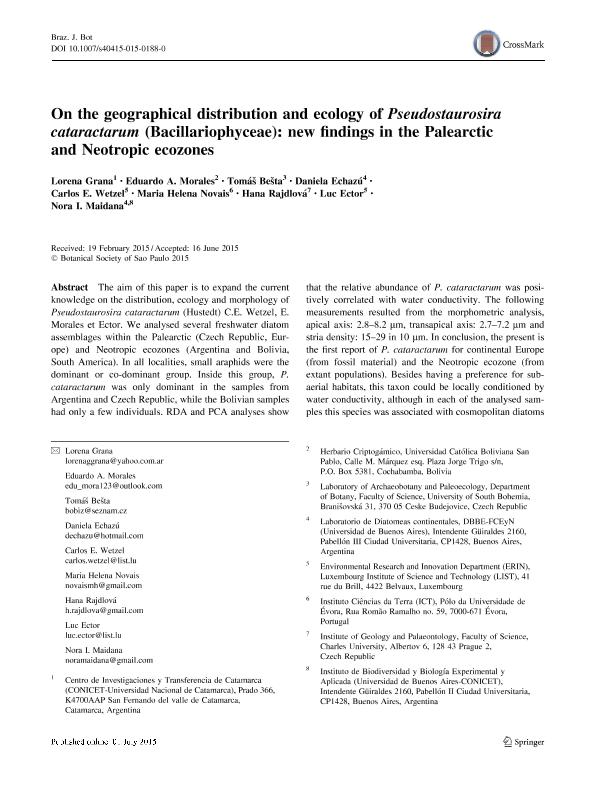Mostrar el registro sencillo del ítem
dc.contributor.author
Grana, Lorena Giselle

dc.contributor.author
Morales, Eduardo A.
dc.contributor.author
Besta, Tomas
dc.contributor.author
Echazú, Daniela
dc.contributor.author
Wetzel, Carlos E.
dc.contributor.author
Novais, Maria Helena
dc.contributor.author
Rajdlová, Hana
dc.contributor.author
Ector, Luc
dc.contributor.author
Maidana, Nora Irene

dc.date.available
2018-09-25T15:06:11Z
dc.date.issued
2015-07
dc.identifier.citation
Grana, Lorena Giselle; Morales, Eduardo A.; Besta, Tomas; Echazú, Daniela; Wetzel, Carlos E.; et al.; On the geographical distribution and ecology of Pseudostaurosira cataractarum (Bacillariophyceae): new findings in the Palearctic and Neotropic ecozones; Sociedad Botánica de Sao Paulo; Revista Brasileira de Botanica; 38; 4; 7-2015; 809-821
dc.identifier.issn
0100-8404
dc.identifier.uri
http://hdl.handle.net/11336/60854
dc.description.abstract
The aim of this paper is to expand the current knowledge on the distribution, ecology and morphology of Pseudostaurosira cataractarum (Hustedt) C.E. Wetzel, E. Morales et Ector. We analysed several freshwater diatom assemblages within the Palearctic (Czech Republic, Europe) and Neotropic ecozones (Argentina and Bolivia, South America). In all localities, small araphids were the dominant or co-dominant group. Inside this group, P. cataractarum was only dominant in the samples from Argentina and Czech Republic, while the Bolivian samples had only a few individuals. RDA and PCA analyses show that the relative abundance of P. cataractarum was positively correlated with water conductivity. The following measurements resulted from the morphometric analysis, apical axis: 2.8–8.2 µm, transapical axis: 2.7–7.2 µm and stria density: 15–29 in 10 µm. In conclusion, the present is the first report of P. cataractarum for continental Europe (from fossil material) and the Neotropic ecozone (from extant populations). Besides having a preference for subaerial habitats, this taxon could be locally conditioned by water conductivity, although in each of the analysed samples this species was associated with cosmopolitan diatoms that are tolerant to a wide range of environmental conditions. Based on the morphometric analyses in studied populations, we propose that the size range for the apical and transapical axes of P. cataractarum should be expanded at the lower end of the range. Likewise, the range of stria density should be expanded since it is wider than that presented for the type population from Indonesia (Java). Consequently, an emended description is presented based on our study and on published data on type and fossil populations.
dc.format
application/pdf
dc.language.iso
eng
dc.publisher
Sociedad Botánica de Sao Paulo
dc.rights
info:eu-repo/semantics/openAccess
dc.rights.uri
https://creativecommons.org/licenses/by-nc-sa/2.5/ar/
dc.subject
Araphid Diatoms
dc.subject
Bacillariophyta
dc.subject
Europe
dc.subject
Neotropic
dc.subject
Palearctic
dc.subject
Pseudostaurosira Cataractarum
dc.subject
South America
dc.subject.classification
Otras Ciencias Biológicas

dc.subject.classification
Ciencias Biológicas

dc.subject.classification
CIENCIAS NATURALES Y EXACTAS

dc.title
On the geographical distribution and ecology of Pseudostaurosira cataractarum (Bacillariophyceae): new findings in the Palearctic and Neotropic ecozones
dc.type
info:eu-repo/semantics/article
dc.type
info:ar-repo/semantics/artículo
dc.type
info:eu-repo/semantics/publishedVersion
dc.date.updated
2018-09-05T15:50:48Z
dc.identifier.eissn
1806-9959
dc.journal.volume
38
dc.journal.number
4
dc.journal.pagination
809-821
dc.journal.pais
Brasil

dc.journal.ciudad
San Pablo
dc.description.fil
Fil: Grana, Lorena Giselle. Consejo Nacional de Investigaciones Científicas y Técnicas. Centro de Investigaciones y Transferencia de Catamarca. Universidad Nacional de Catamarca. Centro de Investigaciones y Transferencia de Catamarca; Argentina
dc.description.fil
Fil: Morales, Eduardo A.. Universidad Católica Boliviana San Pablo; Bolivia
dc.description.fil
Fil: Besta, Tomas. University of South Bohemia; República Checa
dc.description.fil
Fil: Echazú, Daniela. Universidad de Buenos Aires. Facultad de Ciencias Exactas y Naturales. Departamento de Biodiversidad y Biología Experimental. Laboratorio de Diatomeas Continentales; Argentina
dc.description.fil
Fil: Wetzel, Carlos E.. Luxembourg Institute of Science and Technology; Luxemburgo
dc.description.fil
Fil: Novais, Maria Helena. University Of Évora; Portugal
dc.description.fil
Fil: Rajdlová, Hana. Charles University; República Checa
dc.description.fil
Fil: Ector, Luc. Luxembourg Institute of Science and Technology; Luxemburgo
dc.description.fil
Fil: Maidana, Nora Irene. Consejo Nacional de Investigaciones Científicas y Técnicas. Oficina de Coordinación Administrativa Ciudad Universitaria. Instituto de Biodiversidad y Biología Experimental y Aplicada. Universidad de Buenos Aires. Facultad de Ciencias Exactas y Naturales. Instituto de Biodiversidad y Biología Experimental y Aplicada; Argentina
dc.journal.title
Revista Brasileira de Botanica

dc.relation.alternativeid
info:eu-repo/semantics/altIdentifier/url/https://link.springer.com/article/10.1007/s40415-015-0188-0
dc.relation.alternativeid
info:eu-repo/semantics/altIdentifier/doi/http://dx.doi.org/10.1007/s40415-015-0188-0
Archivos asociados
